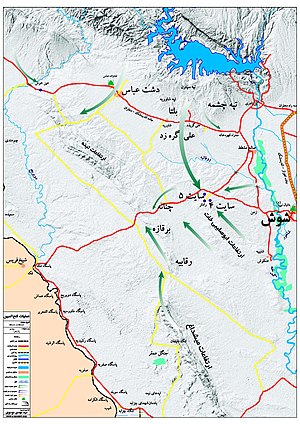| Battle of Shush (Operation Fath ol-Mobin) | |||||||||
|---|---|---|---|---|---|---|---|---|---|
| Part of Iran–Iraq War | |||||||||
 Operation Fath ol-Mobin, Map | |||||||||
| |||||||||
| Belligerents | |||||||||
|
|
| ||||||||
| Commanders and leaders | |||||||||
|
|
| ||||||||
| Strength | |||||||||
| 80,000–160,000 soldiers |
80,000–100,000 regulars 40,000 Pasdaran 30,000 Basij 15,000 militia | ||||||||
| Casualties and losses | |||||||||
|
8,000 killed 361 tanks, IFVs & APCs, 18 aircraft, 300 vehicles, 50 artillery pieces & 30 engineering vehicles destroyed |
4,000 killed 196 tanks and ≈200 APC's destroyed[1] | ||||||||
Operation Fath-ol-Mobin (Persian: عملیات فتحالمبین, a Quranic phrase meaning "Undeniable Victory" or "Manifest Victory") was a major Iranian military operation conducted during the Iran–Iraq War, in March 1982 and resulted to the Battle of Shush. The operation was led by Lt. General Ali Sayad Shirazi and was conducted in four phases.
Some believe that this operation was the turning point in the war[3][4] and that it led to the eviction of Iraqi troops from Khuzestan. Others (including Efraim Karsh) believe it was actually the operation working in tandem with others which led to the expulsion of Iraqi troops from southern Iran. He believes that in fact, Operation Beit ol-Moqaddas, which lasted from April to May 1982, had the greatest effect, because the Iranians were able to liberate the strategically important city of Khorramshahr.
- ^ a b c Razoux, Pierre (2015). The Iran-Iraq War. Harvard University Press, 2015. pp. 199–200. ISBN 978-0674915718.
- ^ http://www.tebyan.net/newindex.aspx?pid=5921
- ^ Iran Chamber Society: History of Iran: Iran-Iraq War 1980-1988
- ^ Farrokh, Kaveh (20 December 2011). Iran at War: 1500-1988. Oxford: Osprey Publishing. ISBN 9781780962214.